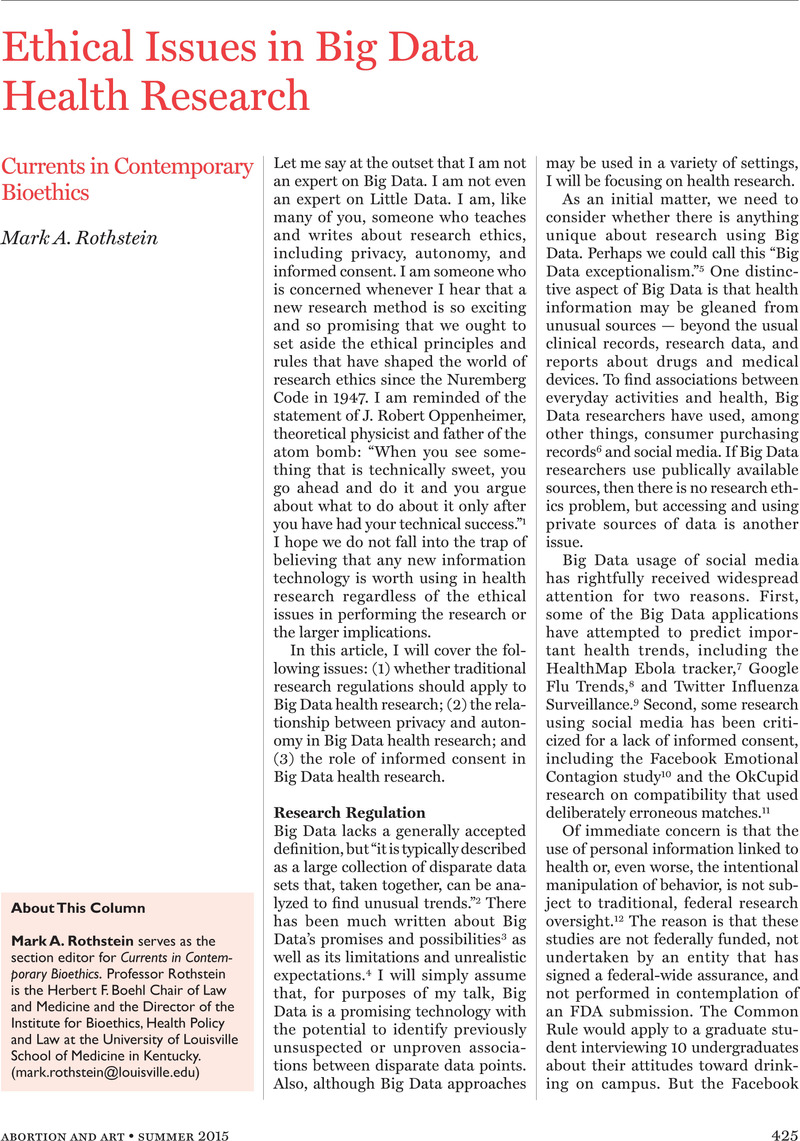Crossref Citations
This article has been cited by the following publications. This list is generated based on data provided by Crossref.
Wasser, Thomas
Haynes, Kevin
Barron, John
and
Cziraky, Mark
2015.
Using ‘big data’ to validate claims made in the pharmaceutical approval process.
Journal of Medical Economics,
Vol. 18,
Issue. 12,
p.
1013.
Rothstein, Mark A.
2016.
Some Lingering Concerns about the Precision Medicine Initiative.
Journal of Law, Medicine & Ethics,
Vol. 44,
Issue. 3,
p.
520.
David Strang, Kenneth
and
Sun, Zhaohao
2016.
Meta-analysis of big data security and privacy: Scholarly literature gaps.
p.
4035.
Monteith, Scott
Glenn, Tasha
Geddes, John
Whybrow, Peter C.
and
Bauer, Michael
2016.
Big data for bipolar disorder.
International Journal of Bipolar Disorders,
Vol. 4,
Issue. 1,
Bledsoe, Marianna J.
Henderson, Marianne
Tassé, Anne-Marie
and
Knoppers, Bartha M.
2016.
International Biobanking Summit V: Harmonizing Privacy Laws to Enable International Biobank Research.
Biopreservation and Biobanking,
Vol. 14,
Issue. 5,
p.
452.
Hashem, Ibrahim Abaker Targio
Anuar, Nor Badrul
Gani, Abdullah
Yaqoob, Ibrar
Xia, Feng
and
Khan, Samee Ullah
2016.
MapReduce: Review and open challenges.
Scientometrics,
Vol. 109,
Issue. 1,
p.
389.
Barnes, Rebecca O.
Shea, Katheryn E.
and
Watson, Peter H.
2017.
The Canadian Tissue Repository Network Biobank Certification and the College of American Pathologists Biorepository Accreditation Programs: Two Strategies for Knowledge Dissemination in Biobanking.
Biopreservation and Biobanking,
Vol. 15,
Issue. 1,
p.
9.
Roberts, Jessica L
Pereira, Stacey
and
McGuire, Amy L
2017.
Should you profit from your genome?.
Nature Biotechnology,
Vol. 35,
Issue. 1,
p.
18.
Lipworth, Wendy
Mason, Paul H.
Kerridge, Ian
and
Ioannidis, John P. A.
2017.
Ethics and Epistemology in Big Data Research.
Journal of Bioethical Inquiry,
Vol. 14,
Issue. 4,
p.
489.
Rahimzadeh, V.
2017.
Progress and Challenges in Precision Medicine.
p.
171.
Drazen, Jeffrey M.
Harrington, David P.
McMurray, John J.V.
Ware, James H.
Woodcock, Janet
Grady, Christine
Cummings, Steven R.
Rowbotham, Michael C.
McConnell, Michael V.
Ashley, Euan A.
and
Kang, Gagandeep
2017.
Informed Consent.
New England Journal of Medicine,
Vol. 376,
Issue. 9,
p.
856.
Lewis, Jan R.R.
Kerridge, Ian
and
Lipworth, Wendy
2017.
Use of Real-World Data for the Research, Development, and Evaluation of Oncology Precision Medicines.
JCO Precision Oncology,
p.
1.
Strang, Kenneth David
and
Sun, Zhaohao
2017.
Big Data Paradigm: What is the Status of Privacy and Security?.
Annals of Data Science,
Vol. 4,
Issue. 1,
p.
1.
Riggare, Sara
Unruh, Kenton
Sturr, Jasmine
Domingos, Josefa
Stamford, Jonathan
Svenningsson, Per
and
Hägglund, Maria
2017.
Patient-driven N-of-1 in Parkinson’s Disease.
Methods of Information in Medicine,
Vol. 56,
Issue. S 01,
p.
e123.
Rothstein, Mark A.
2017.
Structural Challenges of Precision Medicine.
Journal of Law, Medicine & Ethics,
Vol. 45,
Issue. 2,
p.
274.
Ludwin, Samuel K
and
Murray, T Jock
2017.
Dilemmas in medical ethics in the age of big data.
Multiple Sclerosis Journal,
Vol. 23,
Issue. 10,
p.
1306.
Bui, Alex A.T.
and
Van Horn, John Darrell
2017.
Envisioning the future of ‘big data’ biomedicine.
Journal of Biomedical Informatics,
Vol. 69,
Issue. ,
p.
115.
Stahl, Bernd Carsten
Rainey, Stephen
Harris, Emma
and
Fothergill, B Tyr
2018.
The role of ethics in data governance of large neuro-ICT projects.
Journal of the American Medical Informatics Association,
Vol. 25,
Issue. 8,
p.
1099.
Jacquemin, Bernard
Schöpfel, Joachim
Chaudiron, Stéphane
and
Kergosien, Eric
2018.
L'éthique en contexte info-communicationnel numérique.
p.
71.
Schneble, Christophe Olivier
Elger, Bernice Simone
and
Shaw, David
2018.
The Cambridge Analytica affair and Internet‐mediated research.
EMBO reports,
Vol. 19,
Issue. 8,





